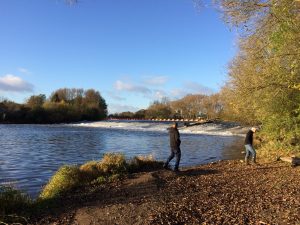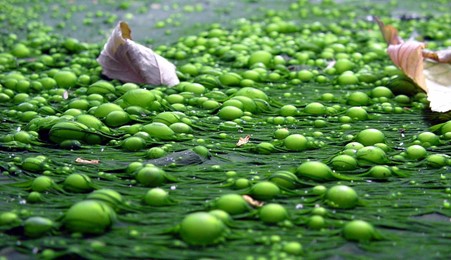
We love the ‘All About’ series, published on the Severn Rivers Trust website. These blogs have been written by Unlocking the Severn volunteers and apprentices, so we figured we’d share them here too! See the original blog on the Severn Rivers website HERE.
Written by Safiya Dixon, a volunteer for Severn Rivers Trust and Unlocking the Severn.
Picture your local river. Perhaps you are one of the lucky ones, clear water, lush riparian plants housing a magnificent magnitude of fauna, birds calling to each other across the torrent, and glimmers of fish darting below. Or perhaps you are one of many more whose riverbanks only teem with plastic, and turbid, chemical-slicken waters hide any indication of what remains of life below; a pristine ecosystem being a fragmented, murky memory. If you fall into the latter category, you may then find yourself, like me, questioning what led to such a sorry state of affairs. Unfortunately the answer to this often points to humans, be it through littering, dumping of waste in waterways, and the like. An aspect that also increasingly contributes to the degradation of rivers, commonly due to the actions of humans, yet often isn’t as readily discussed, is eutrophication.
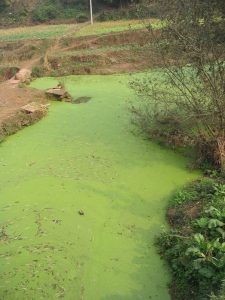
A eutrophic river by eutrophication & hypoxia, courtesy of Creative Commons
What is Eutrophication?
The term eutrophication denotes the “over-enrichment of water by nutrients such as nitrogen and phosphorous”. Although this may occur naturally to some extent, it is largely evident that anthropogenic actions, such as the input of wastewater from factories straight into rivers, exacerbates the incidence of eutrophication by many magnitudes [8]. As a result of the water in these waterways becoming excessively laden with nutrients, photosynthetic organisms such as algae flourish, using these life-supporting nutrients to expand their presence. Consequently, as the algae form a blanket across the surface, limited light can penetrate through, which can in turn hinder the ability of primary producers located on the riverbed from photosynthesising, depleting a valuable source of food from the ecosystem in the form of organic plant matter [7].
These aquatic flora also form highly important microhabitats for small fish, and insects, and so in their absence, many other species will also be affected [2]. Moreover, eventually the algal blooms will sufficiently dissipate the nutrients present to an extent that can no longer support them, leading to mass algal die-off. This dead algae is then broken down by microbes naturally located in the river water, a process which requires dissolved oxygen, and depletes it to the extent that the water is rendered hypoxic – in other words, with such low dissolved oxygen presence, life underwater is unable to be sustained [2].
As you can imagine, this has disastrous effects on the ecosystem in its entirety, leading to further death of aquatic flora and fauna.
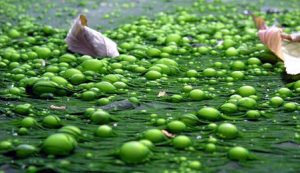
Close-up of algae in a eutrophic river by eutrophication & hypoxia, courtesy of Creative Commons
A widespread issue
At present, 55% of the country’s rivers are at risk of being damaged by eutrophication, due to excessive presence of phosphorus derived from pollution. This doesn’t include the 5164 km of rivers already affected, highlighting the necessity for instigating change and negating such in the future [3]. These statistics issue a stark reminder on the dire situation we currently face. However, all is not lost. Innovative new ideas to decrease the risk of eutrophication or handle algal blooms if such does occur are currently being formulated. It must be noted, nevertheless, that these strategies are only to prevent damage as a last resort. To truly face the issue effectively, far greater attention is required on mitigating the risk of eutrophication in the first instance.
A potential solution?
In the meantime, one such method to restore rivers which have been adversely affected by eutrophication is currently under investigation by scientists. This is the use of spheres formed from lanthanum. Lanthanum is a soft metal which strongly attracts phosphorus and chitosan (derived from shellfish and widely used in science for its absorptive properties), which work together in culmination to draw out excess phosphorus from waterways [4]. The speed at which this system operates looks promising, reducing the risk of a eutrophication event if phosphorus was to leach into the river somehow. However further research is required: for example, using this in the field, not just in a laboratory. Also to investigate is how the efficiency of the absorbing spheres may be altered by the characteristics of the river water it may be used in, as with any potential effects it may have on the ecosystem.
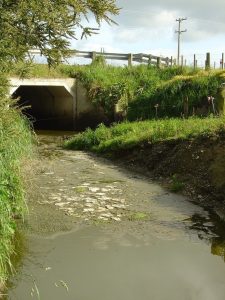
Water pollution from a dairy operation by eutrophication and hypoxia, courtesy of Creative Commons.
Another avenue currently been explored is the use of biomanipulation to deplete the presence of algae in a waterway that is already being affected by eutrophication. In such a case, secondary consumers – those that eat organisms that are primary consumers (herbivores)- are removed from the ecosystem, allowing the herbivores to flourish, and thus down-regulate the presence of phytoplankton, another photosynthetic organism which blooms due to excess presence of nutrients in eutrophic rivers, by consuming it en masse [7]. However, again, further research is required on how best to implement this method, as removing any species from an ecosystem can have disastrous effects if interspecies relationships are overlooked, even to a slight extent [5]. Moreover, this method has largely been modelled on closed bodies of water, such as lakes and ponds, and may not be practical for use in river systems, where there is constant water flow and changes in habitat types throughout the length of the river.
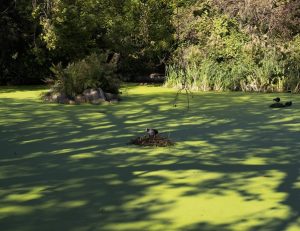
A eutrophic lake by London Less Travelled, courtesy of Creative Commons.
Conclusions
It is clear that methods of treating waters exposed to eutrophication, or its precursing excess presence of nutrients, are being explored. However, as previously mentioned, these methods don’t target preventing nutrient efflux into water ways in the first place. To successfully achieve this, we need to rethink how products containing things such as nitrogen and phosphorus are used, both in societal and economic ways. This could be as simple as reducing the use of fertilisers on gardens, using low-phosphorus content detergents in homes, or improving farming practices, to prevent such entering draining systems and making their way into waterways. Further actions include more rigorous legislative guidance for businesses that handle chemicals, including an Act dedicated to eutrophication, and holding greater accountability for companies that breach such [6]. For, as is so aptly put by Sir David Attenborough, “Real success can only come if there is a change in our societies and in our economics and in our politics” – the good health of our waterways depend on it [1].
Reference list:
[1] Attenborough, D. 2020. David Attenborough: Five quotes to make you think. [Online]. [Accessed 26 February 2021]. Available from: https://www.bbc.co.uk/newsround/51131823
[2] Chislock, M.F., Doster, E., Zitomer, R.A. and Wilson, A.E. 2013. Eutrophication: Causes, Consequences, and Controls in Aquatic Ecosystems. Nature Education Knowledge. 4 (4), p.10.
[3] Environment Agency. 2019. Phosphorus and Freshwater Eutrophication Pressure Narrative. [Online]. [Accessed 24 February 2021]. Available from: https://consult.environment-agency.gov.uk/environment-and-business/challenges-and-choices/user_uploads/phosphorus-pressure-rbmp-2021.pdf
[4] Liu, B., Yu, Y., Han, Q., Lou, S., Zhang, L. and Zhang, W. 2020. Fast and efficient phosphate removal on lanthanum-chitosan composite synthesised by controlling the amount of cross-linking agent. International Journal of Biological Macromolecules. 157 (1), pp. 247-258.
[5] Marris, E. 2011. Ecologists propose ousting species to save ecosystems. [Online]. [Accessed 25 February 2021]. Available from: https://www.scientificamerican.com/article/ecologists-propose-oust/
[6] OpenLearn. 2020. Eutrophication. [Online]. [Accessed 27 February 2021]. Available from: https://www.open.edu/openlearn/nature-environment/environmental-studies/eutrophication/content-section-4.5.2
[7] Sierp, M.T., Qin, J.G. and Recknagel, F. 2009. Biomanipulation: a review of biological control measures in eutrophic waters and the potential for Murray cod Maccullochella peelii peelii to promote water quality in temperate Australia. Reviews in Fish Biology and Fisheries. 19 (1), pp. 143-165.
[8] World Resources Institute. No date. About Eutrophication. [Online]. [Accessed 24 February 2021]. Available from: https://www.wri.org/our-work/project/eutrophication-and-hypoxia/about-eutrophication


